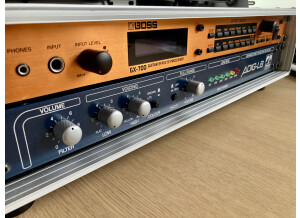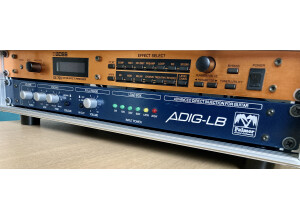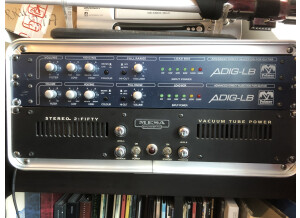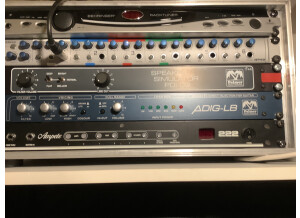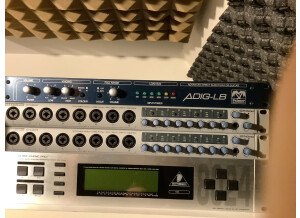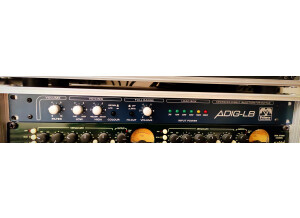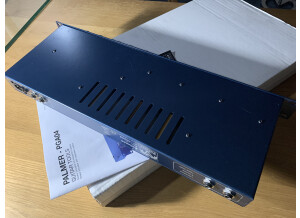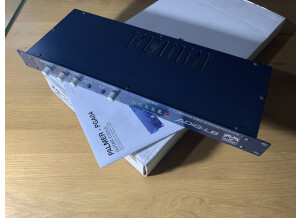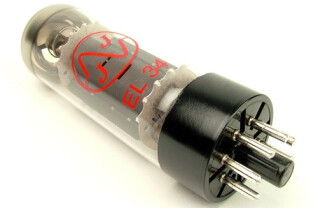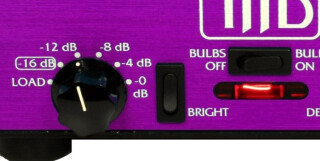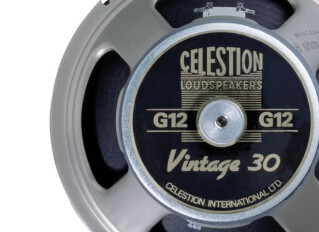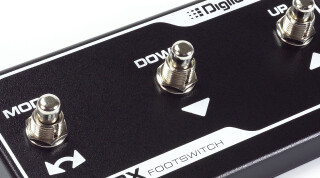PGA 04 classified ad
Alerte nouvelle annonceImages
Videos
Reviews
4.0/5(4 reviews)
25 %
50 %
25 %
Write a user review
Good to have in your tool box...
Published on 03/27/11 at 16:03The Palmer PDI-04 also known as ADIG-LB (Analog Direct injection guitar-load box), is an analog speaker simulator/8 ohm load box.
On the front you have controls for volume for the speaker simulated outs with it's bass and treble control, as well as a voicing switch that simulates the properties of either a closed back 4x12 or an open back 2x12, next to it is the full range control with a high cut switch when using it as line out box. As well as the load level LEDs that let you know how hard you're taxing the box. It can take 120 watts, so running a 70s marshall full tilt will be asking for trouble since those even though they're rated at 100 watts usually put out in the neighborhood of...…
On the front you have controls for volume for the speaker simulated outs with it's bass and treble control, as well as a voicing switch that simulates the properties of either a closed back 4x12 or an open back 2x12, next to it is the full range control with a high cut switch when using it as line out box. As well as the load level LEDs that let you know how hard you're taxing the box. It can take 120 watts, so running a 70s marshall full tilt will be asking for trouble since those even though they're rated at 100 watts usually put out in the neighborhood of...…
Read more
The Palmer PDI-04 also known as ADIG-LB (Analog Direct injection guitar-load box), is an analog speaker simulator/8 ohm load box.
On the front you have controls for volume for the speaker simulated outs with it's bass and treble control, as well as a voicing switch that simulates the properties of either a closed back 4x12 or an open back 2x12, next to it is the full range control with a high cut switch when using it as line out box. As well as the load level LEDs that let you know how hard you're taxing the box. It can take 120 watts, so running a 70s marshall full tilt will be asking for trouble since those even though they're rated at 100 watts usually put out in the neighborhood of 150 watts when cranked.
On the rear you have speaker in and speaker through 1/4 inch jacks, and 2 1/4 unbalanced outs with separate ground lift switches and a balanced XLR out.
To use for recording heads direct into the board, or loading amps down to use in a rack, wet/dry or wet/dry/wet set-up are the two things I use this for.
Here's where it gets funny...I don't really like its sound as a speaker simulator very much. There are plenty of software choices I think do a much, much better job at that, especially with super high gain sounds. Now having said that, I've been in enough situations where for some reason the engineer always tried to get esoteric on miking the guitar amp, instead of sticking a Shure SM57 on the speaker and then adding room mics to taste they end up with every odd choice for a guitar mic in their mic closet and you stand there thinking to yourself I should just plug into a POD since my glorious tone got completely messed up.
On those gigs I ask the engineer to print a "safety track" which is the Palmer direct to the board.
The end result 9 out of 10 times has always been the same. The Palmer track ends up being used. Now with a good engineer, and well miked cab...there's no need for it.
As a load box line-out to integrate your head into effects/rack set up is where for me the Palmer shines.
I have used it for many years and would buying it again in a heart beat because it has saved my butt many times as a speaker simulator although I'm not fond of how it sounds.
As a line out box it's a must have for me.
For guys that have to have no stage volume but want to run their fave tube amps I highly recommend it as well.
On the front you have controls for volume for the speaker simulated outs with it's bass and treble control, as well as a voicing switch that simulates the properties of either a closed back 4x12 or an open back 2x12, next to it is the full range control with a high cut switch when using it as line out box. As well as the load level LEDs that let you know how hard you're taxing the box. It can take 120 watts, so running a 70s marshall full tilt will be asking for trouble since those even though they're rated at 100 watts usually put out in the neighborhood of 150 watts when cranked.
On the rear you have speaker in and speaker through 1/4 inch jacks, and 2 1/4 unbalanced outs with separate ground lift switches and a balanced XLR out.
To use for recording heads direct into the board, or loading amps down to use in a rack, wet/dry or wet/dry/wet set-up are the two things I use this for.
Here's where it gets funny...I don't really like its sound as a speaker simulator very much. There are plenty of software choices I think do a much, much better job at that, especially with super high gain sounds. Now having said that, I've been in enough situations where for some reason the engineer always tried to get esoteric on miking the guitar amp, instead of sticking a Shure SM57 on the speaker and then adding room mics to taste they end up with every odd choice for a guitar mic in their mic closet and you stand there thinking to yourself I should just plug into a POD since my glorious tone got completely messed up.
On those gigs I ask the engineer to print a "safety track" which is the Palmer direct to the board.
The end result 9 out of 10 times has always been the same. The Palmer track ends up being used. Now with a good engineer, and well miked cab...there's no need for it.
As a load box line-out to integrate your head into effects/rack set up is where for me the Palmer shines.
I have used it for many years and would buying it again in a heart beat because it has saved my butt many times as a speaker simulator although I'm not fond of how it sounds.
As a line out box it's a must have for me.
For guys that have to have no stage volume but want to run their fave tube amps I highly recommend it as well.
See less
01
»
Okay, seriously, but not essential
Published on 04/14/14 at 08:33 (This content has been automatically translated from French)This is a hardware analog simulator made by a baffle SM57. The technology is based on tungsten lamp.
It is a rack-mount model comprising:
front:
- Knob to adjust the mix between the dry sound coming out of the head and the sound produced by the simulator
- A knob to adjust the voicing of the cabinet: a 2x10 cabinet with 4x12
- A knob to adjust the tone: is the micro placement, distance from the center of the bowl and its distance from the baflle
- A knob to adjust the volume output
- A button to enable or disable the filter 6kHz
- A button preset color
- 5 LED display of power received by the Palmer
rear:
- Jack speaker
- THRU, again to exit the cabinet thingy
...…
It is a rack-mount model comprising:
front:
- Knob to adjust the mix between the dry sound coming out of the head and the sound produced by the simulator
- A knob to adjust the voicing of the cabinet: a 2x10 cabinet with 4x12
- A knob to adjust the tone: is the micro placement, distance from the center of the bowl and its distance from the baflle
- A knob to adjust the volume output
- A button to enable or disable the filter 6kHz
- A button preset color
- 5 LED display of power received by the Palmer
rear:
- Jack speaker
- THRU, again to exit the cabinet thingy
...…
Read more
This is a hardware analog simulator made by a baffle SM57. The technology is based on tungsten lamp.
It is a rack-mount model comprising:
front:
- Knob to adjust the mix between the dry sound coming out of the head and the sound produced by the simulator
- A knob to adjust the voicing of the cabinet: a 2x10 cabinet with 4x12
- A knob to adjust the tone: is the micro placement, distance from the center of the bowl and its distance from the baflle
- A knob to adjust the volume output
- A button to enable or disable the filter 6kHz
- A button preset color
- 5 LED display of power received by the Palmer
rear:
- Jack speaker
- THRU, again to exit the cabinet thingy
- 2 mono jack outputs
- A dual mono XLR output
- 2 buttons ground / lift
Simple and complete level connectivity, nothing to say. I wish I could have an impedance of 4, 8 or 16ohms selector. Most micrometers are in 8 ohms but exite versions 4 and 16ohms. For example, if I connect an old Marshall head into 4 ohms (no 8 ohm output), I only have access to 60% of its power, which in itself is sufficient for the studio.
Simple configuration, the manual provides a lot of information at the settings, connections them are trivial. You should know that the two magic buttons are HIGH and LOW: one can select the speaker config (number of HP, bowl) and one microphone placement. It's supposed simulter all that, there are no specific screen, it's just the philosophy of the manufacturer.
This is where the shoe pinches, as the sound may seem nice alone, as it does not replace all taking a baflle with a microphone. Tried with my sound engineer for recording guitar and bass, we had nice try anything, we did not find the depth and grain of a cabinet + microphone jack. Therefore the product for me does not keep its promises in terms of sound and seem more useful than a direct box which loadbox.
I kept two years before selling it. In comparison with a baffle, its contribution in terms of sound is insignificant. The question is whether it is really worth snapping 250 euros or 400 euros secondhand nine direct box which load box. The sound alone is good anyway, it is also significant to see small lights turn on and therefore the power emitted by the head. The material is strong, the connection and settings are complete, the intention is laudable that the notes not too bad ...
It is a rack-mount model comprising:
front:
- Knob to adjust the mix between the dry sound coming out of the head and the sound produced by the simulator
- A knob to adjust the voicing of the cabinet: a 2x10 cabinet with 4x12
- A knob to adjust the tone: is the micro placement, distance from the center of the bowl and its distance from the baflle
- A knob to adjust the volume output
- A button to enable or disable the filter 6kHz
- A button preset color
- 5 LED display of power received by the Palmer
rear:
- Jack speaker
- THRU, again to exit the cabinet thingy
- 2 mono jack outputs
- A dual mono XLR output
- 2 buttons ground / lift
Simple and complete level connectivity, nothing to say. I wish I could have an impedance of 4, 8 or 16ohms selector. Most micrometers are in 8 ohms but exite versions 4 and 16ohms. For example, if I connect an old Marshall head into 4 ohms (no 8 ohm output), I only have access to 60% of its power, which in itself is sufficient for the studio.
Simple configuration, the manual provides a lot of information at the settings, connections them are trivial. You should know that the two magic buttons are HIGH and LOW: one can select the speaker config (number of HP, bowl) and one microphone placement. It's supposed simulter all that, there are no specific screen, it's just the philosophy of the manufacturer.
This is where the shoe pinches, as the sound may seem nice alone, as it does not replace all taking a baflle with a microphone. Tried with my sound engineer for recording guitar and bass, we had nice try anything, we did not find the depth and grain of a cabinet + microphone jack. Therefore the product for me does not keep its promises in terms of sound and seem more useful than a direct box which loadbox.
I kept two years before selling it. In comparison with a baffle, its contribution in terms of sound is insignificant. The question is whether it is really worth snapping 250 euros or 400 euros secondhand nine direct box which load box. The sound alone is good anyway, it is also significant to see small lights turn on and therefore the power emitted by the head. The material is strong, the connection and settings are complete, the intention is laudable that the notes not too bad ...
See less
31
»
Published on 02/18/06 at 02:08 (This content has been automatically translated from French)
Direct box (DI) at the output of power amp and Loadbox up to 200 watts into 8 ohms only!
It connects to the speaker output of a guitar amp (head, Poweramp, combo if it has a speaker output).
It serves as a DI (signal to a line level / speaker emulation by connecting on a console). He also serves as a load box (or dummy box): it can not use speaker or cabinet!
1 rack unit high, perforated for ventilation hood (it transforms the energy into heat of the amp, like the Marshall Powerbrake).
At the front
- 6 LEDs indicate the input volume (3, 10, 30, 60, 120 and 200 watts).
Full Range Section (dry signal)
- A volume knob for the sound output untreated.
- A switch to...…
It connects to the speaker output of a guitar amp (head, Poweramp, combo if it has a speaker output).
It serves as a DI (signal to a line level / speaker emulation by connecting on a console). He also serves as a load box (or dummy box): it can not use speaker or cabinet!
1 rack unit high, perforated for ventilation hood (it transforms the energy into heat of the amp, like the Marshall Powerbrake).
At the front
- 6 LEDs indicate the input volume (3, 10, 30, 60, 120 and 200 watts).
Full Range Section (dry signal)
- A volume knob for the sound output untreated.
- A switch to...…
Read more
Direct box (DI) at the output of power amp and Loadbox up to 200 watts into 8 ohms only!
It connects to the speaker output of a guitar amp (head, Poweramp, combo if it has a speaker output).
It serves as a DI (signal to a line level / speaker emulation by connecting on a console). He also serves as a load box (or dummy box): it can not use speaker or cabinet!
1 rack unit high, perforated for ventilation hood (it transforms the energy into heat of the amp, like the Marshall Powerbrake).
At the front
- 6 LEDs indicate the input volume (3, 10, 30, 60, 120 and 200 watts).
Full Range Section (dry signal)
- A volume knob for the sound output untreated.
- A switch to high-pass filter (> 6 kHz) for the signal.
Section Filter (signal processed by the DI)
- A volume knob of the processed signal (Filter).
- EQ knobs for bass and treble.
- Switch Lite / Brown (color signal)
At the rear
- A mono input jack 6.35 HP (use an absolute speaker cable!)
- An HP Output (through).
- An output line level XLR and two unbalanced jack line outputs 6.35. Each type has a line out the switch of the mass ejection (to avoid ground loops generating hum).
The beast is bulky compared to other Powersoak / DI / Loadboxes I had (Weber and Marshall Powerbrake Mass). Misery to put on a head, as it is in the format rack.
Sutout and it is mono. Well, that's good, my amp too. But if we play in stereo (especially with a Poweramp) b'en'll have to buy two. Really not cool.
Another very annoying, it only works in 8 ohms. Well, the vast majority of modern amplifiers work with different impedances, with 8 ohms. But it can cause problems for not using this impedance heads. Damage, Mass (optional) and Marshall (in series) worked with various impedances.
It is powered by the electric current sent through the HP output of the amp.
Using ultra quiche, as with an amp head or an effects pedal, turn knob until it sounds. And it's not hard to make it sound!
Please note again, only use speaker cables for input and output on the HP Palmer, or you could make holy damage to your amp head and Palmer!
In short, as DI / Loadbox, b'en I have not found better, and I've tried a lot!
B'en there, I took my snaps. I only use it for recording at the moment, not tested on PA.
I have tried other alternatives for a clean guitar sound with computer music, passing by both DI (Amp or Preamp Behringer GI100 DI lamps Ultra-G, Red Box HK, Weber Mass, only HP emulation of a Pod Xt Live), relying only on modeling (Behringer VAMP2 and Pod Xt Live).
In short, computer music, now that I no longer use my PGA connected directly behind my Engl Powerball.
I have rarely managed to get a computer music his drinking ... only with the Palmer + Engl ... and before that, with my little VAMP2 alone
Used with the direct sound and the sound filtered. Frankly, the only direct sound is not great: too much treble. We suspected. Otherwise, they would not put a DI ...
With its mix of filtered or direct sound (low%) and filtered sound (very large%), I am flabbergasted!
I've never had a sound as good (even with my awful VAMP2). None of the DI I had been so effective, none have agreed to my little ears. I never managed to get out of anything convincing the Pod Xt Live.
And then, bam, happiness!
Well, it takes a little work the EQ (very effective, usually I put the bass and treble on 4 / 10 max!).
The switch Lite / Brown gives two different coloration to the sound filtered:
- The Lite brings the color of a cabinet open. A grain not really exceptional (but I have not yet fully exploited the beast, far from it!).
- The Brown'm having really, it has a grain closer to a closed 4x12 Celestion Vintage 30. In short, I use and abuse of the sound at the Palmer Brown
Come on, hop a chtit sample (http://jacksonfreak.free.fr/audio/test_pga_02.mp3) of Palmer saturax (vii, always the same)
In short, as DI / Loadbox, b'en I have not found better, and I've tried a lot!
B'en now, after much research, buy / sell and other garbage flipflaps DI, modeling of widgets, I finally found the gem in my ears! I am completely satisfied for the moment (as long as it lasts)!
I have been tempted by the Koch LB120 II, but I found much more easily Palmer (in any shop Germanic) that Koch. And given the samples of 05 PGA posted here (which is not loadbox, but stereo) (Bravo Kida and others), I tried the PGA 04. And I was right!
Defects? It is mono, and most importantly, it is quite expensive.
But as it sounds good (personal opinion that is only my opinion).
WARNING: PGA04 is a dummy box / DI, but by no means an attenuator / powersoak!
It connects to the speaker output of a guitar amp (head, Poweramp, combo if it has a speaker output).
It serves as a DI (signal to a line level / speaker emulation by connecting on a console). He also serves as a load box (or dummy box): it can not use speaker or cabinet!
1 rack unit high, perforated for ventilation hood (it transforms the energy into heat of the amp, like the Marshall Powerbrake).
At the front
- 6 LEDs indicate the input volume (3, 10, 30, 60, 120 and 200 watts).
Full Range Section (dry signal)
- A volume knob for the sound output untreated.
- A switch to high-pass filter (> 6 kHz) for the signal.
Section Filter (signal processed by the DI)
- A volume knob of the processed signal (Filter).
- EQ knobs for bass and treble.
- Switch Lite / Brown (color signal)
At the rear
- A mono input jack 6.35 HP (use an absolute speaker cable!)
- An HP Output (through).
- An output line level XLR and two unbalanced jack line outputs 6.35. Each type has a line out the switch of the mass ejection (to avoid ground loops generating hum).
The beast is bulky compared to other Powersoak / DI / Loadboxes I had (Weber and Marshall Powerbrake Mass). Misery to put on a head, as it is in the format rack.
Sutout and it is mono. Well, that's good, my amp too. But if we play in stereo (especially with a Poweramp) b'en'll have to buy two. Really not cool.
Another very annoying, it only works in 8 ohms. Well, the vast majority of modern amplifiers work with different impedances, with 8 ohms. But it can cause problems for not using this impedance heads. Damage, Mass (optional) and Marshall (in series) worked with various impedances.
It is powered by the electric current sent through the HP output of the amp.
Using ultra quiche, as with an amp head or an effects pedal, turn knob until it sounds. And it's not hard to make it sound!
Please note again, only use speaker cables for input and output on the HP Palmer, or you could make holy damage to your amp head and Palmer!
In short, as DI / Loadbox, b'en I have not found better, and I've tried a lot!
B'en there, I took my snaps. I only use it for recording at the moment, not tested on PA.
I have tried other alternatives for a clean guitar sound with computer music, passing by both DI (Amp or Preamp Behringer GI100 DI lamps Ultra-G, Red Box HK, Weber Mass, only HP emulation of a Pod Xt Live), relying only on modeling (Behringer VAMP2 and Pod Xt Live).
In short, computer music, now that I no longer use my PGA connected directly behind my Engl Powerball.
I have rarely managed to get a computer music his drinking ... only with the Palmer + Engl ... and before that, with my little VAMP2 alone
Used with the direct sound and the sound filtered. Frankly, the only direct sound is not great: too much treble. We suspected. Otherwise, they would not put a DI ...
With its mix of filtered or direct sound (low%) and filtered sound (very large%), I am flabbergasted!
I've never had a sound as good (even with my awful VAMP2). None of the DI I had been so effective, none have agreed to my little ears. I never managed to get out of anything convincing the Pod Xt Live.
And then, bam, happiness!
Well, it takes a little work the EQ (very effective, usually I put the bass and treble on 4 / 10 max!).
The switch Lite / Brown gives two different coloration to the sound filtered:
- The Lite brings the color of a cabinet open. A grain not really exceptional (but I have not yet fully exploited the beast, far from it!).
- The Brown'm having really, it has a grain closer to a closed 4x12 Celestion Vintage 30. In short, I use and abuse of the sound at the Palmer Brown
Come on, hop a chtit sample (http://jacksonfreak.free.fr/audio/test_pga_02.mp3) of Palmer saturax (vii, always the same)
In short, as DI / Loadbox, b'en I have not found better, and I've tried a lot!
B'en now, after much research, buy / sell and other garbage flipflaps DI, modeling of widgets, I finally found the gem in my ears! I am completely satisfied for the moment (as long as it lasts)!
I have been tempted by the Koch LB120 II, but I found much more easily Palmer (in any shop Germanic) that Koch. And given the samples of 05 PGA posted here (which is not loadbox, but stereo) (Bravo Kida and others), I tried the PGA 04. And I was right!
Defects? It is mono, and most importantly, it is quite expensive.
But as it sounds good (personal opinion that is only my opinion).
WARNING: PGA04 is a dummy box / DI, but by no means an attenuator / powersoak!
See less
50
»
Published on 01/18/10 at 03:34 (This content has been automatically translated from French)
Technological level, there is a tungsten lamp in it, I do not quite understand what it is, but obviously it's a component that is called to be changed from time to time, especially if you use this device to dissipate large power (above 100 W in particular). The rest is based transistor, which is important, as we shall see below.
This is a rack of course, I refer to post kinder_guano to describe the connectors.
If a machine is still very full, at least for my usage.
The general setup is super simple, it should delve a bit in the manual to understand what are the different knobs. The manual is quite clear, but it is English or German.
Use of pga04 proves a breeze.
...…
This is a rack of course, I refer to post kinder_guano to describe the connectors.
If a machine is still very full, at least for my usage.
The general setup is super simple, it should delve a bit in the manual to understand what are the different knobs. The manual is quite clear, but it is English or German.
Use of pga04 proves a breeze.
...…
Read more
Technological level, there is a tungsten lamp in it, I do not quite understand what it is, but obviously it's a component that is called to be changed from time to time, especially if you use this device to dissipate large power (above 100 W in particular). The rest is based transistor, which is important, as we shall see below.
This is a rack of course, I refer to post kinder_guano to describe the connectors.
If a machine is still very full, at least for my usage.
The general setup is super simple, it should delve a bit in the manual to understand what are the different knobs. The manual is quite clear, but it is English or German.
Use of pga04 proves a breeze.
kinder_guano seemed to find that Palmer's injury only works in 8 ohms.
I watched a little, and it seems to me that this is not important as long as the resistance encountered by the amplifier output exceeds its minimum acceptable value.
In this case, most amps are 8 ohms or 4 ohms, 16 ohms very rarely, although it apparently was the case for some amps. The Palmer is therefore almost any amp, except in very rare exception.
Afterwards, he admitted that connect the air for example an amplifier into 4 ohms to 8 ohms impedance external sound and will change the total power. Lowering the impedance encountered at the output, we increase the power of the amp (so that when there is no impedance, you get a theoretically infinite power --- as well say that your amp Crame.) So in this case, the reverse is true, this will reduce the power output data.
Therefore a priori not to play for compatibility with amp requiring output impedance of 8 ohms or 4.
Obviously I'm not electronics, so correct me if I'm wrong <img class="smiley" src="/images/audiofanzine/interface/smileys/icon_wink.gif" alt="" />
I refer readers to post kinder_guano which pretty much describes what I think the sound quality of pga04!
However, I want to make a small clarification Me: When you play beyond a certain power, the transistors inside the bug can come into resonance, and therefore you will hear a case out of Palmer sizzling corresponding to what you play. This has no effect on the sound that you get the output recording, but it is curious at first.
The explanation comes from customer service to Palmer. So do not expect total silence on this machine, but hey .... It makes about as much of a ruckus fridge discreet, and only when you play
I use it for only a few days.
Very satisfied, and honestly, I think acquiring a second to work with any future Poweramp stereo, or else to connect two amps in recording.
Customer service is super nice and very responsive, even by mail! I really recommend this brand, good quality material, durable, guaranteed for 5 years (!), What more?
Many people on the Internet seem to find it expensive, but personally I think it is very much its price!
I do it again so that choice without any hesitation.
This is a rack of course, I refer to post kinder_guano to describe the connectors.
If a machine is still very full, at least for my usage.
The general setup is super simple, it should delve a bit in the manual to understand what are the different knobs. The manual is quite clear, but it is English or German.
Use of pga04 proves a breeze.
kinder_guano seemed to find that Palmer's injury only works in 8 ohms.
I watched a little, and it seems to me that this is not important as long as the resistance encountered by the amplifier output exceeds its minimum acceptable value.
In this case, most amps are 8 ohms or 4 ohms, 16 ohms very rarely, although it apparently was the case for some amps. The Palmer is therefore almost any amp, except in very rare exception.
Afterwards, he admitted that connect the air for example an amplifier into 4 ohms to 8 ohms impedance external sound and will change the total power. Lowering the impedance encountered at the output, we increase the power of the amp (so that when there is no impedance, you get a theoretically infinite power --- as well say that your amp Crame.) So in this case, the reverse is true, this will reduce the power output data.
Therefore a priori not to play for compatibility with amp requiring output impedance of 8 ohms or 4.
Obviously I'm not electronics, so correct me if I'm wrong <img class="smiley" src="/images/audiofanzine/interface/smileys/icon_wink.gif" alt="" />
I refer readers to post kinder_guano which pretty much describes what I think the sound quality of pga04!
However, I want to make a small clarification Me: When you play beyond a certain power, the transistors inside the bug can come into resonance, and therefore you will hear a case out of Palmer sizzling corresponding to what you play. This has no effect on the sound that you get the output recording, but it is curious at first.
The explanation comes from customer service to Palmer. So do not expect total silence on this machine, but hey .... It makes about as much of a ruckus fridge discreet, and only when you play
I use it for only a few days.
Very satisfied, and honestly, I think acquiring a second to work with any future Poweramp stereo, or else to connect two amps in recording.
Customer service is super nice and very responsive, even by mail! I really recommend this brand, good quality material, durable, guaranteed for 5 years (!), What more?
Many people on the Internet seem to find it expensive, but personally I think it is very much its price!
I do it again so that choice without any hesitation.
See less
51
»
Audio excerpts
-
00:0000:12

-
00:0000:08

-
00:0000:28

Tech. sheet
- Manufacturer: Palmer
- Model: PGA 04
- Category: Guitar Cabinet Simulators
- Package weight:3.4 kg
- Added in our database on: 09/01/2005
We have no technical specifications for this product
but your help will be much welcomed
»
Other categories in Guitar Amp Parts & Accessories
Other names: pga 04, pga04





